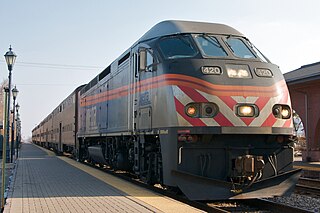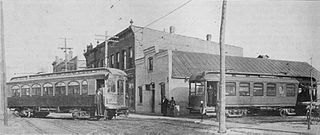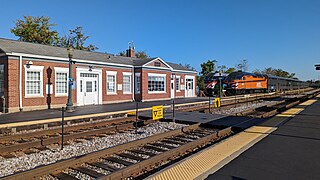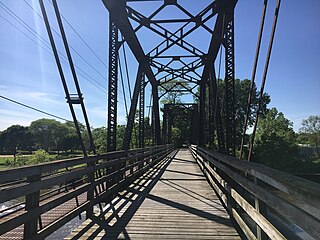Related Research Articles

The Union Pacific West Line (UP-W) is a Metra commuter rail line operated by Union Pacific Railroad in Chicago, Illinois and its western suburbs. Metra does not refer to its lines by particular colors, but the timetable accents for the Union Pacific West line are "Kate Shelley Rose" pink, honoring an Iowa woman who saved a Chicago & North Western Railway train from disaster in 1881. Green and yellow were already selected for the Union Pacific North Line and Union Pacific Northwest Line, respectively, so pink was chosen for this line. Therefore, the UP-W is the only Metra line that uses a color to honor a person instead of a fallen flag railroad. Until the late 1940s the line had a branch to Freeport, Illinois. It diverged from the main line at West Chicago and had stations at Elgin, Marengo, Belvidere, Rockford, Freeport, and other communities. The line was once known as the Chicago & Northwestern/West Line until UP took over the C&NW in 1995. All Metra trains on this line terminated at Geneva until 2006, when the line was extended to its present terminus in Elburn. The line runs as part of the Union Pacific Railroad's Geneva Subdivision.

The Milwaukee District West Line (MD-W) is a Metra commuter rail line in Chicago, Illinois, and its western suburbs. Metra does not refer to any of its lines by a particular color, but the timetable accents for the Milwaukee District West line are dark "Arrow Yellow," honoring the Milwaukee Road's Arrow passenger train. Trains are dispatched from the Canadian Pacific Kansas City Railway's American headquarters in Minneapolis.

The Chicago Aurora and Elgin Railroad (CA&E), known colloquially as the "Roarin' Elgin" or the "Great Third Rail", was an interurban railroad that operated passenger and freight service on its line between Chicago and Aurora, Batavia, Geneva, St. Charles, and Elgin, Illinois. The railroad also operated a small branch to Mt. Carmel Cemetery in Hillside and owned a branch line to Westchester.

The Fox River Trolley Museum is a railroad museum in South Elgin, Illinois. Incorporated in 1961 as R.E.L.I.C., it opened in 1966 and became the Fox River Trolley Museum in 1984.

The Elgin and Belvidere Electric Company was a 36-mile (58 km) interurban line that connected Belvidere, Illinois and Elgin, Illinois. It was the central link in the interurban network connecting Freeport, Rockford, Elgin, and Chicago which included the Rockford and Interurban Railway to the west and the Chicago, Aurora and Elgin Railroad to the east. The line was operational from 1907 until 1930. In 1927, the line was extended to Rockford over a line of the Rockford and Interurban.

Oak Park is a station on the Chicago 'L' system, serving the Blue Line's Forest Park branch and Oak Park, Illinois. The station is alongside the Eisenhower Expressway between Oak Park Avenue and East Avenue, near the Oak Park Conservatory. The auxiliary entrance on East Avenue is half a block from the Oak Park Conservatory.

Forest Park is a station on the Chicago Transit Authority's 'L' system, located in the village of Forest Park, Illinois and serving the Blue Line. Before the Congress Line was built, it served as terminal for the Garfield Line. It is the western terminus of the Forest Park branch. The station was known as Des Plaines until 1994. It is also referred to as the Forest Park Transit Center by Pace because it is a major terminal for Pace buses. The station contains a 1,051-space Park and Ride lot which uses the "Pay and Display" system, in which fees are paid at the lot entrance. It is located south of the Baltimore and Ohio Chicago Terminal Railroad tracks which curve to the north of the station towards Madison Street where the line rechristens itself to the Canadian National Railway's Waukesha Subdivision.

The Jewett Car Company was an early 20th-century American industrial company that manufactured streetcars and interurban cars.
The Aurora, Elgin & Fox River Electric (AE&FRE), was an interurban railroad that operated freight and passenger service on its line paralleling the Fox River. It served the communities of Carpentersville, Dundee, Elgin, South Elgin, St. Charles, Geneva, Batavia, North Aurora, Aurora, Montgomery, and Yorkville in Illinois. It also operated local streetcar lines in both Aurora and Elgin.

Elgin is one of three stations on Metra's Milwaukee District West Line in Elgin, Illinois. The station is 36.6 miles (58.9 km) away from Chicago Union Station, the eastern terminus of the line. In Metra's zone-based fare system, Elgin is in zone 4. As of 2018, Elgin is the 116th busiest of Metra's 236 non-downtown stations, with an average of 411 weekday boardings.

The Fox River Trail is a multi-use path in Illinois along the Fox River. Largely in Kane County, the trail connects the communities of Algonquin, Carpentersville, Dundee, Elgin, South Elgin, St. Charles, Geneva, Batavia, North Aurora, Aurora, Montgomery, and Oswego.
The Chicago, Aurora and DeKalb Railroad was a 29-mile (47 km) interurban line which operated from 1906 to 1923 and connected the cities of Aurora and DeKalb, Illinois. The line made connections in Aurora with the Aurora, Elgin and Fox River Electric Company, the Chicago, Aurora and Elgin Railroad, and the Aurora, Plainfield and Joliet Railroad. Entry into Aurora was made via streetcar trackage of the Aurora, Elgin and Fox River Electric. Over the course of its history, the railroad used internal combustion, steam, and finally electric traction as motive power.
The Aurora, Plainfield and Joliet was a 22-mile (35 km) interurban railroad which operated between its namesake cities of Aurora, Illinois, Plainfield and Joliet in northern Illinois from October 21, 1904 to 1924.

Marshfield was a rapid transit station on the Chicago "L" in service between 1895 and 1954. Constructed by the Metropolitan West Side Elevated Railroad, it was the westernmost station of the Metropolitan's main line, which then diverged into three branches. Marshfield was also served by the Aurora Elgin and Chicago Railway (AE&C) and its descendant the Chicago Aurora and Elgin Railroad (CA&E), an interurban, between 1905 and 1953.
Canal was a rapid transit station located on the Metropolitan main line of the Chicago "L" that was in service from 1895 to 1958, when the entire main line was replaced by the Congress Line located in the median of the nearby Eisenhower Expressway. Starting in 1927, the interurban Chicago Aurora and Elgin Railroad (CA&E) also served the station, continuing until 1953. The station connected with Chicago's Union Station, which was one of the city's rail terminals. One of the busiest stations on the Metropolitan's routes, and of the "L" in general, it opened a second entrance on Clinton Street in 1914.
Bellwood was a station on the Chicago Aurora and Elgin Railroad (CA&E) serving Bellwood, Illinois, from 1902 to 1957. An adjacent station, serving the Westchester branch, existed for rapid transit purposes on the Chicago "L" between 1926 and 1951.

St. Louis was a rapid transit station on the Chicago "L" between 1895 and 1953. It was constructed by the Metropolitan West Side Elevated Railroad and served its Garfield Park branch. The Chicago Aurora and Elgin Railroad (CA&E), an interurban serving Chicago's western suburbs, also used the Garfield Park branch's tracks in 1905. To accommodate the mixing of the fast interurban and slow "L" service on a two-track line, two crossovers were installed on either side of the St. Louis station to let CA&E trains pass "L" trains in 1911.
Kedzie was a rapid transit station on the Chicago "L", serving the Garfield Park branch of its Metropolitan West Side Elevated Railroad, from 1895 to 1958. Between 1905 and 1953, it also served the Chicago Aurora and Elgin Railroad (CA&E), an interurban using Garfield Park tracks, between 1905 and 1953.
References
- 1 2 "Elgin". GreatThirdRail.org. Retrieved February 12, 2023.
- 1 2 Bolton, Lang & Turner 1914, p. 18
- ↑ Bolton, Lang & Turner 1914, Sheet 20
- ↑ Weller & Stark 1999, p. 3
- ↑ Bolton, Lang & Turner 1914, p. 1
- ↑ Bolton, Lang & Turner 1914, pp. 5 & 19
- ↑ "Report Elgin-Rockford Line Will Quit Service". Chicago Tribune. Vol. 89, no. 59. March 10, 1930. p. 3. Retrieved February 12, 2023– via Newspapers.com.
- ↑ Weller & Stark 1999, p. 20